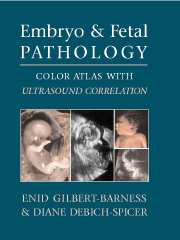Book contents
- Frontmatter
- Contents
- Foreword by John M. Opitz
- Preface
- Acknowledgments
- 1 The Human Embryo and Embryonic Growth Disorganization
- 2 Late Fetal Death, Stillbirth, and Neonatal Death
- 3 Fetal Autopsy
- 4 Ultrasound of Embryo and Fetus: General Principles
- 5 Abnormalities of Placenta
- 6 Chromosomal Abnormalities in the Embryo and Fetus
- 7 Terminology of Errors of Morphogenesis
- 8 Malformation Syndromes
- 9 Dysplasias
- 10 Disruptions and Amnion Rupture Sequence
- 11 Intrauterine Growth Retardation
- 12 Fetal Hydrops and Cystic Hygroma
- 13 Central Nervous System Defects
- 14 Craniofacial Defects
- 15 Skeletal Abnormalities
- 16 Cardiovascular System Defects
- 17 Respiratory System
- 18 Gastrointestinal Tract and Liver
- 19 Genito-Urinary System
- 20 Congenital Tumors
- 21 Fetal and Neonatal Skin Disorders
- 22 Intrauterine Infection
- 23 Multiple Gestations and Conjoined Twins
- 24 Metabolic Diseases
- Appendices
- Index
23 - Multiple Gestations and Conjoined Twins
Published online by Cambridge University Press: 23 February 2010
- Frontmatter
- Contents
- Foreword by John M. Opitz
- Preface
- Acknowledgments
- 1 The Human Embryo and Embryonic Growth Disorganization
- 2 Late Fetal Death, Stillbirth, and Neonatal Death
- 3 Fetal Autopsy
- 4 Ultrasound of Embryo and Fetus: General Principles
- 5 Abnormalities of Placenta
- 6 Chromosomal Abnormalities in the Embryo and Fetus
- 7 Terminology of Errors of Morphogenesis
- 8 Malformation Syndromes
- 9 Dysplasias
- 10 Disruptions and Amnion Rupture Sequence
- 11 Intrauterine Growth Retardation
- 12 Fetal Hydrops and Cystic Hygroma
- 13 Central Nervous System Defects
- 14 Craniofacial Defects
- 15 Skeletal Abnormalities
- 16 Cardiovascular System Defects
- 17 Respiratory System
- 18 Gastrointestinal Tract and Liver
- 19 Genito-Urinary System
- 20 Congenital Tumors
- 21 Fetal and Neonatal Skin Disorders
- 22 Intrauterine Infection
- 23 Multiple Gestations and Conjoined Twins
- 24 Metabolic Diseases
- Appendices
- Index
Summary
TYPES OF TWINS AND THEIR ORIGINS
For naturally conceived multiple pregnancy, about 70% are dizygotic (DZ) twins, resulting from double or multiple ovulations in the same cycle; this is attributed to higher levels of maternal follicle-stimulating hormone (FSH) or increased FSH receptor sensitivity. Monozygotic (MZ) twinning involves postzygotic splitting, resulting in two or more embryos. This can occur at any time up to about 14 days postconception.
A third type of twin, the “polar body” twin, is very rare.
DETERMINATION OF ZYGOSITY
Zygosity determination is best carried out by analysis of restriction fragment length polymorphisms in variable number tandem repeat sequences of DNA, extracted from chorionic villus samples, amniotic fluid cells, peripheral blood white cells, placenta, cord and membranes, and tissues sampled at autopsy, including macerated stillborn fetuses (Table 23.1).
PLACENTAL ANATOMY OF ZYGOSITY
Of MZ twins, about one-third have dichorionic (DC) placentas (separate or fused disks), while two-thirds have truly single monochorionic (MC) placentas (Figure 23.1). Most MC placentas have two amniotic cavities (MC, DA), while a minority (about 1% of all twins) have a single amniotic cavity (MC, MA). Conjoined twins are MZ, and most are MC, MA.
- Type
- Chapter
- Information
- Embryo and Fetal PathologyColor Atlas with Ultrasound Correlation, pp. 622 - 634Publisher: Cambridge University PressPrint publication year: 2004
- 1
- Cited by



